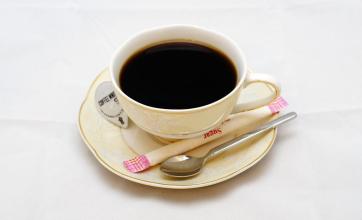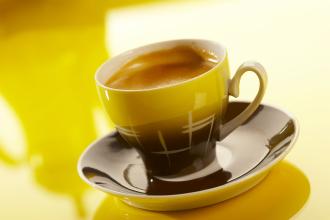Roasting degree, process and characteristics of coffee beans
1. Drying
In the early stage of baking, the raw beans begin to absorb heat, and the water inside gradually evaporates. At this time, the color gradually changed from green to yellow or light brown, and the silver film began to fall off, you can smell a faint smell of grass. The main function of this stage is to remove moisture, which accounts for about half of the baking time, because water is a good heat transfer conductor and helps to bake the internal material of coffee beans. Therefore, although the aim is to remove water, the baker will make good use of the temperature of the water and properly control it so that it will not evaporate too quickly; in general, it is best to control the water to reach the boiling point and turn into steam in 10 minutes. At this time, the internal material is fully cooked, and the water begins to evaporate, rushing out of the outside of the coffee beans.
2. High temperature decomposition
Baked to about 160 degrees Celsius, the water inside the beans will evaporate into gas and begin to rush out of the outside of the coffee beans. At this time, the interior of the raw bean changed from endothermic to exothermic, resulting in the first burst sound. After the bursting sound, it turns to endothermic again, and the pressure inside the coffee bean is extremely high, up to 25 atmospheric pressure. Heat and pressure begin to deconstruct the original tissue to form new compounds that create the taste and taste of coffee; at about 190 degrees Celsius, the transition between endothermic and exothermic occurs again. Of course, high temperature cracking continues to occur, coffee beans from brown to dark brown, gradually entering the stage of re-baking.
3. Cooling
Coffee must be cooled immediately after roasting, quickly stop the pyrolysis at high temperature and lock the flavor. Otherwise, if the high temperature in the beans continues to work, the aromatic substances will be burned. There are two cooling methods: one is air-cooled and the other is water-cooled. The air-cooled type needs a lot of cold air to cool the coffee beans quickly within 5 minutes. In the field of professional baking, large roasters are equipped with a tray with a rotatable driving arm; when the baking is completed, the beans are automatically fed into the tray, and the fan at the bottom of the tray is immediately activated to blow cold air. And the pushing arm stirs the coffee beans to cool them. Although the speed of the water-cooled type is slow, it is clean and does not pollute, and it can better retain the aroma of the coffee, so it is used by the selected coffee industry. The water-cooled method is to spray a layer of water mist on the surface of the coffee beans, allowing the temperature to drop rapidly. As the amount of spraying water is very important, it requires precise calculation and control, and will increase the weight of baked beans, which is generally used in large-scale commercial baking.
Baking degree and characteristics
From the point of view of the baking degree, the deeper the baking degree, the stronger the bitter taste; the lighter the baking degree, the stronger the sour taste. The choice of baking degree depends on the characteristics of the coffee bean itself. for coffee beans with strong bitterness and light sour taste, they generally choose a moderate and shallow roasting degree.
1. Shallow baking (Light)
The most mild fried culture, no fragrance and concentration to speak of, the beans are not yet ripe, with the green taste of raw beans, not suitable for grinding and drinking. It's usually used as an experiment.
2. Deep shallow baking (Cinnamon)
Also known as cinnamon baking, for the general popular degree of frying, leaving a strong sour taste. The color of beans is quite similar to that of cinnamon, so it is also called cinnamon baking and its sour taste is aggravated. It is favored by people in the western United States.
3. Shallow medium baking (Media)
The color deepens, easy to extract the original taste of coffee beans, mellow, sour and delicious. Mainly used for mixing coffee.
4. Medium baking (High)
Coffee has a stronger flavor and a lighter sour taste, which is the general roasting method of coffee beans. The sour taste is neutralized and bitter, suitable for coffee such as Blue Mountain and Kilimanjaro. It is loved by Japanese and Nordic people.
5. Deep medium baking (City)
Also known as city baking, bitter taste is stronger than sour taste, almost no sour taste, unique flavor. Coffee suitable for Colombia and Brazil is very popular in New York.
6. Normal baking (FullCity)
Also known as city-wide baking, suitable for brewing iced coffee. No sour taste, mainly bitter taste, bitterness will be aggravated, but high-quality beans will have sweet taste. It is used for iced coffee and is preferred by people in Central and South America.
7. French baking (French)
French baking method, slightly black color, strong bitterness, but also ooze oil, bitterness and concentration are deepened. Coffee used for steam pressurizer.
8. Deep baking (Italian)
Also known as Italian baking, the deepest baking degree, the beans are black and bright, the surface is oozing oil, the bitterness is very strong. At this stage, coffee beans have been seriously carbonized, and it is difficult to distinguish the taste of one kind of coffee bean from another. For Italian steam pressurized coffee.
Baking characteristics all over the world
Cities all over the world have their preference for frying and baking. In Tokyo, micro-deep medium baking is more popular, but slowly it also tends to deep baking. In the West, deep baking has been popular since ancient times. New York, as its name suggests, generally prefers urban baking, but because it is inhabited by different races of people, it sells coffee beans of different roasting levels, which are quite varied. Vienna prefers deep baking. The French prefer French baking, while Italians often use Italian baking. However, in recent years, Italian baking (the most commonly used deep roasting in Brazil and Italy) has been widely used in Europe and the United States, and the coffee made by steam pressurizer is still popular. Deep roasting of Ethiopian coffee beans would be a waste. Because that would lose the unique characteristics of this coffee. Black roasting of Yauco and Kona coffee beans is also bad, because you will lose the classical flavor you pursue when you buy it. When some coffee beans are roasted black, new and interesting qualities will be derived. Mexican coffee beans produce an interesting sweetness when roasted in black. Guatemala Antigua coffee beans seem to retain their sour and fruity flavor when they are deeply roasted, which is difficult for other coffees. Sumatran coffee beans are usually full-grained, but are below medium acidity, lose acidity when roasted deeper, and easily turn into sugar paste. Generally speaking, the darker the baking, the lower the quality. Deeper roasting means losing most of the flavor of the coffee beans.

Important Notice :
前街咖啡 FrontStreet Coffee has moved to new addredd:
FrontStreet Coffee Address: 315,Donghua East Road,GuangZhou
Tel:020 38364473
- Prev

Introduction to the cultivation Flavor of Coffee beans
Types of coffee beans: blue mountain mocha, Santos, Brazil, Santos, Colombia, Mantlin, Guatemala, Romsda integrated coffee tree is a small shrub growing in the tropical highlands, its fruit is red or yellow, and the internal seeds are what we call coffee beans. At present, coffee beans are grown in about 66 countries in the world, and they can be classified as Arabica, Robusta and Liberica.
- Next

The characteristics of fine coffee beans
The characteristics of fine coffee beans 1. Fine coffee beans must be high quality beans without blemishes. It has to have outstanding flavor, not without bad taste, but taste especially good. 2. Fine coffee beans must be fine varieties, such as the original bourbon, mocha, tipica species, these species produce coffee beans with unique aroma and flavor, far more than other species can
Related
- Does Rose Summer choose Blue, Green or Red? Detailed explanation of Rose Summer Coffee plots and Classification in Panamanian Jade Manor
- What is the difference between the origin, producing area, processing plant, cooperative and manor of coffee beans?
- How fine does the espresso powder fit? how to grind the espresso?
- Sca coffee roasting degree color card coffee roasting degree 8 roasting color values what do you mean?
- The practice of lattes: how to make lattes at home
- Introduction to Indonesian Fine Coffee beans-- Java Coffee producing area of Indonesian Arabica Coffee
- How much will the flavor of light and medium roasted rose summer be expressed? What baking level is rose summer suitable for?
- Introduction to the characteristics of washing, sun-drying or wet-planing coffee commonly used in Mantenin, Indonesia
- Price characteristics of Arabica Coffee Bean Starbucks introduction to Manning Coffee Bean Taste producing area Variety Manor
- What is the authentic Yega flavor? What are the flavor characteristics of the really excellent Yejasuffi coffee beans?

